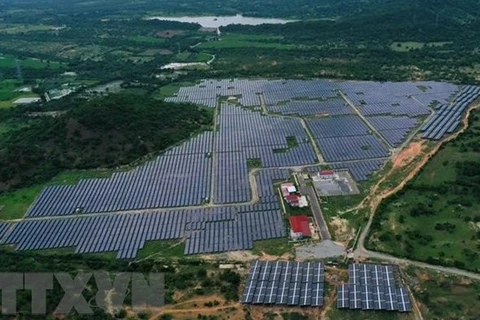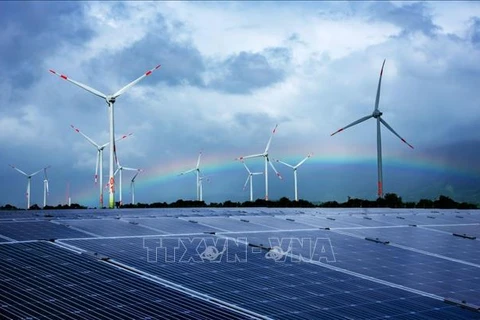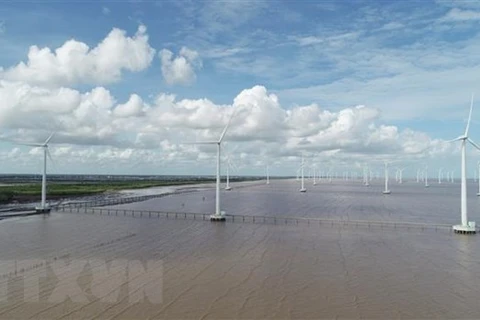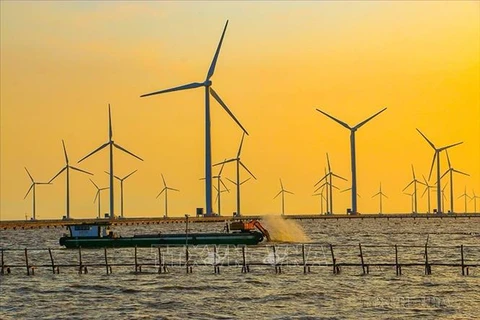 Trung Nam Group’s renewable energy power complex in Thuan Bac district, Ninh Thuan province (Photo: VietnamPlus)
Trung Nam Group’s renewable energy power complex in Thuan Bac district, Ninh Thuan province (Photo: VietnamPlus) Hanoi (VNA) - Vietnam's status as a regional hub and stronghold for renewable energy is rapidly growing, the Entrepreneur Magazine said in an article on January 23.
Eric Chin, the author of the article, quoted the Asian Development Bank (ADB) as saying that Vietnam is expecting a recovery of 6.5% in GDP growth in 2022. Consequently, power consumption has increased more than 11% per year, significantly faster than the national GDP. This is feeding an almost insatiable demand for more power generation and investment.
However, domestic fossil fuel production cannot keep up with demand, requiring Vietnam to rely on foreign markets to acquire enough resources to power its infrastructure. Therefore, Vietnam's reliance on imported energy to run its electric system and climate change are catalysts for the government to pivot towards renewable energy.
According to the article, Vietnam realises that the need for a green energy transition has never been more urgent. As one of Southeast Asia's fastest-growing economies, the country has proved its commitment to the initiative, particularly when it comes to solar power.
It currently has the most comprehensive installed solar power capacity in Southeast Asia, with 16,500MW generated in 2020. Moreover, Vietnam was among the top 10 nations globally, with the most solar energy capacity installed in 2020.
Given Vietnam's high solar PV potential and ambitious green energy targets by 2050, the country has every opportunity to become a global leader in renewables, the author wrote, adding that there is also a compelling rationale for establishing wind energy projects in Vietnam, because the country some of the greatest wind resources in the region with a potential of 311 GW.
It also cited market analysts as saying that if Vietnam maintains its rapid expansion of renewable energy, it will rise much higher in the rankings, perhaps overtaking nations like Australia and Italy in renewable energy development and creative solutions.
Vietnam has recently seen phenomenal solar photovoltaic (PV) growth, which is just the beginning of the country's vast energy transition away from coal. The country's solar PV capacity increased from 86 MW in 2018 to about 16,500 megawatts (MW) in 2020.
Consequently, Vietnam has surpassed Thailand as the ASEAN country with the greatest installed solar power capacity. Solar PV systems provide roughly 10.6 TWh of electricity in 2020, accounting for nearly 4% of total output.
Rooftop solar will account for approximately half of Vietnam's total solar capacity by 2030. With a promising solar energy production environment, international investors will have difficulty passing up such lucrative investment prospects.
According to the article, the climate and topography of Vietnam make renewable energy, particularly wind power, a significant investment prospect. Vietnam's vast wind resource is thanks to the country's long and narrow geographical shape, consisting of over 3,000 kilometres of coastline, including a mix of hills and mountains.
The World Bank said more than 39% of Vietnam has wind speeds of more than 6 metres per second (m/s) at 65 metres, equivalent to 512 gigawatts (GW) of capacity. Vietnam has excellent potential with 8.6% of its land area suitable for large wind farms.
Setting aside the cost of constructing the necessary transmission infrastructure, Vietnam will need to invest billions of Vietnamese dong to reach this target. Private sector cooperation is imperative given the limitations of government resources and the economic challenges involved. This demand has set the stage for international investors to enter and establish a presence in Vietnam's mostly untapped wind energy sector.
According to the International Energy Agency, Vietnam is Southeast Asia's second-largest electricity user. Energy consumption in the region is among the world's fastest-growing, with demand rising at a steady 6% per year over the past 20 years. According to Techwire Asia, 80% of all energy demand in the region stems from four principal countries, Indonesia, Vietnam, Thailand and Malaysia.
The Vietnamese government's commitment to increasing energy supply and significant public demand for better air quality has been a major driving force. Supporting governmental legislation and policies, including feed-in-tariffs (FiT), attractive tax incentives and land lease waivers are also regarded as fundamental elements fuelling the country's massive renewable energy (RE) growth, said the article./.























